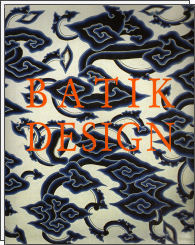EDIZIONE INGLESE 
|
INTRODUCTION
In common with most Asian societies, the people of the Malay world attach great importance to decorated textiles. Apart from obvious applications - garments and other items of practical use - fabrics often have significant symbolic value, expressed by the colours and ornamentation used for their design. Patterns may have ceremonial or religious functions, or indicate the power or status of the owner. Apart from the design, the materials used can also play a role in this respect; damask cloth or silk will be more highly regarded than plain cotton, and additional embellishment, such as the use of gold thread or gold leaf, is an obvious sign of wealth.
Among the most prominent and highly developed decorated textile types in Southeast Asia is batik. The batik sarong and kain panjang, skirt-like garments worn by men and women, have for centuries been - and in rural areas still are - the most prominent dress items in the Malay wardrobe. The finishing of the sarong may vary from a single colour applied to rough, homespun cotton, as worn by village people in parts of Java, to intricate designs executed in many colours on high-quality imported cotton, sometimes with additional decoration in gold leaf. In other instances batik is also used for the decoration of exclusive silk garments.
However, many batik designs have particular symbolic meanings and are not intended for everyday use; rather they are reserved for certain important functions and ceremonies. So in some regions young boys will be dressed in special batik motifs during and immediately after circumcision - an important milestone in a man's life; these designs are thought to have the ability to still pain. Often batik is an important part of bridal attire. Newly weds are regarded as king and queen on their wedding day, and so might be dressed in designs once reserved for royalty. Specific batik cloths may also have a ritual function during pregnancy, childbirth and burial.
Batik had, and to a degree still has, important functions within the Javanese courts of Cirebon, Surakarta and Yogyakarta. At one time certain designs were set aside for the exclusive use of rulers, their families and officials, and were classified as forbidden' for the common people. Such restrictions no longer apply; anyone may use the full range of batik designs and fabrics, even in the traditional kraton (`palace') cities, but younger royals are still educated in the meaning of classical designs, as they are regarded as important elements of the court's cultural heritage. Batik also remains an important part of Javanese court dress.
|
CONTENTS
Introduction
A Brief Cultural History of the Malay World
Batik Technique
Applications of Batik Cloth
Batik Design
Classical Batik
Banji Patterns
Kawung Patterns
Ceplok Patterns
Garis Miring
Nitik Patterns
Floral, Plant aid Animalmotifs
Сimukirran
Isen
Pasisir Batik
Indo-Еuropean Batik
Chinese Influence in Pasisir Batik
Combinations of Patterns and Styles
Pagi-Sore
Batik Hokokai
Batik on Silk
Batik from Cirebon
Batik in Sumatra
Batik from the Malay Peninsula
Glossary
Index
Illustration Credits
Acknowledgements
Selected Bibliography |


Pepin van Roojen
BATIK DESIGN
editore PEPIN
edizione 2001
pagine 192
formato 24x28
softcover
tempo medio evasione ordine
5 giorni
17.50 €
9.00 €
ISBN : 90-5496-005-1
EAN : 9789054960058
|
|